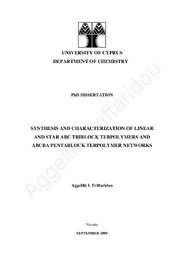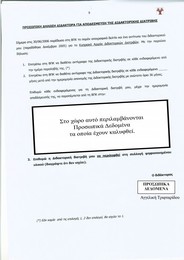| dc.contributor.advisor | Patrikios, Costas S. | en |
| dc.contributor.author | Triftaridou, Aggeliki I. | en |
| dc.coverage.spatial | Κύπρος | el |
| dc.coverage.spatial | Cyprus | en |
| dc.creator | Triftaridou, Aggeliki I. | en |
| dc.date.accessioned | 2012-09-21T07:35:38Z | |
| dc.date.accessioned | 2017-08-03T10:41:11Z | |
| dc.date.available | 2012-09-21T07:35:38Z | |
| dc.date.available | 2017-08-03T10:41:11Z | |
| dc.date.issued | 2006-06 | |
| dc.date.submitted | 2006-06-30 | |
| dc.identifier.uri | https://gnosis.library.ucy.ac.cy/handle/7/39450 | en |
| dc.description | Includes bibliography (p. 204-218). | en |
| dc.description | Thesis (Ph. D.) -- University of Cyprus, Faculty of Pure and Applied Sciences, Department of Chemistry, 2005. | en |
| dc.description | The University of Cyprus Library holds the printed form of the thesis. | en |
| dc.description.abstract | Γραμμικά και αστεροειδή ΑΒΓ τριαδρομερή τριπολυμερή και ΑΒΓΒΑ πενταδρομερή τριπολυμερή πρότυπα πλέγματα, αποτελούμενα από δύο υδρόφιλα μονομερή και ένα υδρόφοβο μονομερές, παρασκευάστηκαν με πολυμερισμό μεταφοράς ομάδας (group transfer polymerization, GTP). Παρασκευάστηκαν επίσης όλα τα αντίστοιχα τυχαία τριπολυμερή. Ο μεθακρυλικός εστέρας της μεθοξυ-εξα(αιθυλενογλυκόλης) [methoxy hexa(ethylene glycol) methacrylate, HEGMA, μη ιοντικός] και ο μεθακρυλικός 2-(διμεθυλαμινο)αιθυλεστέρας [2-(dimethylamino)ethyl methacrylate DMAEMA, θερμοευαίσθητος και ιοντιζόμενος] χρησιμοποιήθηκαν ως τα δύο υδρόφιλα μονομερή, ενώ είτε ο μεθακρυλικός μεθυλεστέρας (methyl methacrylate, MMA) είτε ο μεθακρυλικός κ-βουτυλεστέρας (n-butyl methacrylate, BuMA) χρησίμευσε ως το υδρόφοβο μονομερές. Ο διμεθακρυλικός διεστέρας της αιθυλενογλυκόλης (ethylene glycol dimethacrylate, EGDMA) ήταν ο διασταυρωτής που διασύνδεσε τις γραμμικές αλυσίδες σε αστεροειδή πολυμερή ή πλέγματα. Ο μονοδραστικός εκκινητής 1-μεθοξυ-1-(τριμεθυλοσιλοξυ)-2-μεθυλοπροπένιο (1-methoxy-1-(trimethylsiloxy)-2-methyl propene, MTS) χρησιμοποιήθηκε για τη σύνθεση των γραμμικών και των αστεροειδών τριπολυμερών, ενώ ο διδραστικός εκκινητής 1,4-δισ(μεθοξυ-τριμεθυλο-σιλοξυ-μεθυλενο)κυκλοεξάνιο (1,4-bis(methoxytrimethylsiloxymethylene)cyclohexane, MTSMC) χρησίμευσε για την παρασκευή των πλεγμάτων. Έξι ομάδες τριπολυμερών συντέθηκαν συνολικά, τρεις από τις οποίες αποτελούνταν από γραμμικά και καινοτόμα αστεροειδή τριπολυμερή, ενώ οι υπόλοιπες τρεις αποτελούνταν από καινοτόμα πλέγματα με καλά ορισμένες δομές που παρασκευάστηκαν για πρώτη φορά. Πέντε από τις έξι ομάδες αποτελούνταν από ισομοριακά αδρομερή τριπολυμερή που ήσαν ισομερή διαδοχής τμημάτων, ενώ η έκτη ομάδα αποτελείτο από πλέγματα τριπολυμερών με διαφορετικές περιεκτικότητες στο υδρόφοβο BuMA.
Τα μοριακά βάρη και οι κατανομές των μοριακών βαρών όλων των τριπολυμερών καθώς και των γραμμικών πρόδρομων των πλεγμάτων λήφθηκαν με χρωματογραφία αποκλεισμού μεγέθους (gel permeation chromatography, GPC) σε τετραϋδροφουράνιο (tetrahydrofuran, THF). Τα μοριακά αυτά βάρη είχαν τιμές κοντά στις θεωρητικά αναμενόμενες. Στατική σκέδαση φωτός (static light scattering, SLS) σε THF έδειξε ότι τα αστεροειδή τριπολυμερή έφεραν μεγάλους αριθμούς βραχιόνων, μεταξύ 40 και 80. Οι συστάσεις όλων των τριπολυμερών προσδιορίστηκαν με φασματοσκοπία πυρηνικού μαγνητικού συντονισμού πρωτονίων (proton nuclear magnetic resonance, 1H NMR). Οι προσδιορισθείσες συστάσεις των τριπολυμερών που περιείχαν BuMA ήταν κοντά στις θεωρητικά αναμενόμενες, σε αντίθεση με αυτές των τριπολυμερών που περιείχαν MMA όπου μειωμένη ευκρίνεια στο διαχωρισμό των φασματικών κορυφών δεν επέτρεψε τον ακριβή προσδιορισμό των συστάσεων.
Όλα τα τριπολυμερή χαρακτηρίστηκαν σε υδατικό περιβάλλον. Συγκεκριμένα, οι υδροδυναμικές διάμετροι, οι αριθμοί συσσωμάτωσης, οι θερμοκρασίες νεφέλωσης των γραμμικών και των αστεροειδών τριπολυμερών προσδιορίστηκαν με δυναμική σκέδαση φωτός (dynamic light scattering, DLS), SLS και νεφελομετρία, αντίστοιχα, ενώ οι βαθμοί διόγκωσης (ΒΔ) των τριπολυμερών πλεγμάτων προσδιορίστηκαν σταθμομετρικά. Τα γραμμικά τριπολυμερή σχημάτισαν μικρά μικύλια στο νερό, με το τριπολυμερές που έφερε το υδρόφοβο τμήμα στο κέντρο να σχηματίζει ακόμη μικρότερα μικύλια. Συσσωμάτωση μεταξύ αστεροειδών τριπολυμερών παρατηρήθηκε μόνο σε μία περίπτωση. Τα υπόλοιπα, μη συσσωματωνόμενα, αστεροειδή τριπολυμερή παρουσίασαν υδροδυναμικές διαμέτρους που ήταν εξαρτώμενες από τη σειρά διαδοχής των τμημάτων, κάτι που αντανακλούσε διαφορετικές εσωτερικές δομές. Οι θερμοκρασίες νεφέλωσης των γραμμικών και των αστεροειδών τριπολυμερών εξαρτούνταν από τη σειρά διαδοχής των τμημάτων, με τις θερμοκρασίες νεφέλωσης των αστεροειδών να είναι υψηλότερες από αυτές των γραμμικών λόγω του μεγαλύτερου αριθμού βραχιόνων των αστεροειδών σε σχέση με τους αριθμούς συσσωμάτωσης των μικυλίων των γραμμικών. Τα τυχαία γραμμικά και αστεροειδή τριπολυμερή είχαν τις χαμηλότερες θερμοκρασίες νεφέλωσης λόγω της πλήρους έκθεσης των υδρόφοβων μονάδων τους στο νερό.
Σε αντίθεση με τα γραμμικά και τα αστεροειδή τριπλυμερή, καμία διαφοροποίηση δεν παρατηρήθηκε στη συμπεριφορά των ισομερών πλεγμάτων σε ουδέτερο νερό, αντανακλώντας την πυκνή και με περιορισμένη ευελιξία φύση των πλεγμάτων. Παρόλα ταύτα, διαφοροποιήσεις στους ΒΔ εντοπίστηκαν στα ιοντισμένα πλέγματα, όπου τα πλέγματα βασισμένα σε τυχαία τριπολυμερή διογκώθηκαν περισσότερο από τα πλέγματα πενταδρομερών που ήταν μικροφασικά διαχωρισμένα. Αυτή η διαφορά ήταν μεγαλύτερη στα πιο υδρόφοβα πλέγματα με BuMA, τα οποία επέδειξαν διαφοροποιήσεις και ανάμεσα στους ΒΔ των διαφόρων ισομερών πενταδρομερών πλεγμάτων. Τέλος, οι ΒΔ των πλεγμάτων τόσο σε ουδέτερο όσο και σε όξινο (που επιφέρει ιοντισμό των πλεγμάτων) νερό ελαττώνονταν με αύξηση της σύστασης σε υδρόφοβο BuMA. | el |
| dc.description.abstract | Linear and star ABC triblock terpolymers and ABCBA pentablock terpolymer-based model networks of two hydrophilic and one hydrophobic monomers were synthesized by group transfer polymerization (GTP). All the statistical terpolymer analogues were also prepared. Methoxy hexa(ethylene glycol) methacrylate (HEGMA, nonionic) and 2-(dimethylamino)ethyl methacrylate (DMAEMA, temperature- and pH-sensitive) were employed as the two hydrophilic monomers, whereas either methyl methacrylate (MMA) or n-butyl methacrylate (BuMA) served as the hydrophobic monomer. Ethylene glycol dimethacrylate (EGDMA) was used as the cross-linker to effect the interconnection of the linear chains to stars or networks, respectively. The monofunctional 1-methoxy-1-(trimethylsiloxy)-2-methyl propene (MTS) GTP initiator was employed for the synthesis of the linear and the star terpolymers, whereas the bifunctional 1,4-bis(methoxytrimethylsiloxymethylene)cyclohexane (MTSMC) initiator served for the preparation of the networks. Six terpolymer families were prepared in total, three of which comprised linear or novel star terpolymers, while the other three consisted of novel networks of well-defined structures, the first-known prepared networks of that kind. Five out of the six families comprised equimolar block sequence isomeric terpolymers, whereas the sixth contained network terpolymers with varying BuMA hydrophobic content.
The molecular weights and molecular weight distributions of all the terpolymers and the linear terpolymer precursors to the networks were obtained using gel permeation chromatography (GPC) in tetrahydrofuran (THF) and were found to agree reasonably well with the theoretically expected. Static light scattering (SLS) in THF revealed that the star terpolymers bore a large number of arms, between 40 and 80. The terpolymer compositions were determined by proton nuclear magnetic resonance (1H NMR) spectroscopy. The compositions of the BuMA-containing terpolymers were in accord with the theoretically expected values, whereas lack of peak resolution impaired the accurate composition determination of the MMA-containing terpolymers.
All the terpolymers were characterized in an aqueous environment. In particular, the hydrodynamic diameters, aggregation numbers and cloud points of the linear and star terpolymers were determined using dynamic light scattering (DLS), SLS and turbidimetry, whereas the degrees of swelling (DSs) of the terpolymer networks were measured gravimetrically. The linear terpolymers formed small micelles in water, with the terpolymer having the hydrophobic block in the middle forming even smaller micelles. Star-star aggregation was observed with one block sequence isomer, whereas the non-aggregating stars exhibited block sequence-dependent hydrodynamic diameters, indicating differences in their internal structures. The cloud points of the linear and star terpolymers depended on block sequence, with the cloud points of the stars being higher than those of the linear due to the larger number of arms in the stars than the aggregation numbers in the linears. The statistical linear and stars exhibited the lowest cloud points due to the full exposure of their hydrophobic units to water.
In contrast to the linear and star terpolymers, no differentiation was observed in the behavior of the isomeric networks in neutral water, reflecting the dense and constrained nature of the networks. However, differentiations in the DSs were measured for ionized networks, in which the statistical terpolymer-based isomers swelled more than the pentablock isomers which separated into microphases. This discrepancy was pronounced for the more hydrophobic BuMA-containing networks, which also displayed swelling differences among the isomeric pentablock networks. Finally, the network DSs in both neutral and acidic water decreased as the BuMA hydrophobic content increased. | en |
| dc.format.extent | various paging : ill., diagrs ; 31 cm. | en |
| dc.language.iso | eng | en |
| dc.publisher | Πανεπιστήμιο Κύπρου, Σχολή Θετικών και Εφαρμοσμένων Επιστημών / University of Cyprus, Faculty of Pure and Applied Sciences | |
| dc.rights | info:eu-repo/semantics/openAccess | en |
| dc.rights | Open Access | en |
| dc.subject.lcsh | Copolymers | en |
| dc.subject.lcsh | Monomers | en |
| dc.subject.lcsh | Polymerization | en |
| dc.subject.lcsh | Polymers | en |
| dc.subject.lcsh | Polymers, Analysis | en |
| dc.subject.lcsh | Polymers and polymerization | en |
| dc.subject.lcsh | Polymers and polymerization, Analysis | en |
| dc.title | Synthesis and characterization of linear and star ABC triblock terpolymers and ABCBA pentablock terpolymer networks | en |
| dc.type | info:eu-repo/semantics/doctoralThesis | en |
| dc.contributor.committeemember | Πατρίκιος, Κώστας Σ. | el |
| dc.contributor.committeemember | Λεοντίδης, Επαμεινώνδας | el |
| dc.contributor.committeemember | Τσιτσιλιάνης, Κωνσταντίνος | el |
| dc.contributor.committeemember | Πασχαλίδης, Ιωάννης | el |
| dc.contributor.committeemember | Αναστασιάδης, Σπύρος | el |
| dc.contributor.committeemember | Patrikios, Costas S. | en |
| dc.contributor.committeemember | Leontides, Epameinondas | en |
| dc.contributor.committeemember | Tsitsilianis, Costantinos | en |
| dc.contributor.committeemember | Paschalides, Ioannis | en |
| dc.contributor.committeemember | Anastasiadis, Spiros | en |
| dc.contributor.department | Πανεπιστήμιο Κύπρου, Σχολή Θετικών και Εφαρμοσμένων Επιστημών, Τμήμα Χημείας | el |
| dc.contributor.department | University of Cyprus, Faculty of Pure and Applied Sciences, Department of Chemistry | en |
| dc.identifier.lc | QD381.7.T75 2005 | en |
| dc.author.faculty | Σχολή Θετικών και Εφαρμοσμένων Επιστημών / Faculty of Pure and Applied Sciences | |
| dc.author.department | Τμήμα Χημείας / Department of Chemistry | |
| dc.type.uhtype | Doctoral Thesis | en |
| dc.rights.embargodate | 2006-06-30 | |
| dc.contributor.orcid | Patrikios, Costas S. [0000-0001-8855-0370] | |


